

Like I mentioned earlier, some of the fit is not exact and there is some warping to the parts. UPDATE: My adapter has shipped! More soon! Fingers-crossed! Until then, I'll keep using a cheap Dell USB laser mouse. It won't ship until early April, but promises to allow an original Amiga mouse to work on a USB host like the Pi. Honestly, a modern USB laser mouse is so much better in pretty much every way, but you can't play Marble Madness with a laser mouse! To remedy this, I have ordered the "USB joystick adapter" from Retronic Design. I was a little disappointed to learn that the DB9 connectors on the TS board did not properly emulate the Amiga mouse. I will not be selling these myself - they take WAY TOO LONG to print. Heck, if you want to make and sell them, go for it. Regardless, please tinker with them! Let me know if you make changes or improvements - I'd LOVE to see them! These are distributed without any guarantee of any kind. Unfortunately, this makes them not easily editable. I used a 2D design program to build most of them, then extruded the SVG exports into 3D using. I'm BRAND NEW to this stuff, so I apologize for the lame STL files. My 3D printer can only print items 7"x7"x7" so I had to chop up the design to fit the printer. STL files, a parts list, and instructions for doing this yourself are below. Two weeks later and I have the first version of a four-bracket set for mounting the Pi, TS board, and panel cables! The fit is pretty good, however I already have some design changes in mind that should make it stronger, and some tweaks to make the fit a little better. This would make a clean look from the outside. They would be mounted internally using "heat sets" set into the 3D printed plastic brackets.


All of these could be added later if desired though.įor that clean look, "panel mount" cables would be used to extend the Pi's ports to the back of the Amiga. I also left out composite video and stereo audio. Since I would be using wifi, I did not include ethernet. I needed HDMI for audio and video, power (via micro USB), and two USB-A ports. I wanted a clean look - no nuts or washers visible from outside. My goal for the 3D printed bracket was to make it fit without drilling the original case. So I bought a 3D printer (the excellent and cheap Monoprice Maker Select 3D Printer v2) and got to work. Having seen the work of Corei64 in creating a non-destructive mounting bracket for the Commodore 64C, I was inspired to try this myself. For this, a custom mounting bracket would have to be developed. I punted the floppy drive to another day, and decided to next focus on getting these pieces INTO the Amiga 500. Brilliant! As a bonus, the TS board also has two DB9 ports for connecting vintage joysticks! TS also offers many other USB keyboard adapters, and the proprietor is super friendly and helpful.
#Amiga emulator raspberry pi Pc
The TS board converts the signal from the Amiga 500's keyboard into a standard PC keyboard signal. This board fits in the Amiga 500 and provides a pin header to the Amiga 500's keyboard cable to, and a USB port to connect to your Mac/PC or in this case, Raspberry Pi. There are lots of homebrew projects that connect an original Amiga keyboard to a Pi, but one commercial product caught my attention: Tynemouth Software's (TS) Amiga 500 USB keyboard adapter. The result is that when you turn on the Pi, within a few seconds you are in the Amiga Workbench. The Amiberry/DietPi distribution also does a "quiet boot", bypassing all the usual Unix console messages, and boots directly into a default UAE configuration. Amiberry runs on DietPi - a super slimmed down Debian OS for the Pi - that boots very quickly. Even though Amiberry can emulate an Amiga at warp speeds, I prefer to run mostly stock 5 configs. Speaking of emulators, Amiberry is a terrific Amiga emulator that is optimized for ARM. This is easy - the Raspberry Pi 3B is small, uses very little power, is infinitely hackable, and runs a variety of emulators quite well. Version 1 has accomplished a lot of this, but there is still more to do.įirst up, the host computer. This emulated Amiga had to FEEL like an Amiga. All of this had to be done without permanently modifying - or destroying - any part of the Amiga. My goal for this project was to create an emulated Amiga, but maintain the original aesthetics of the iconic Amiga 500 - down to a functional keyboard, floppy drive, mouse, and joystick ports.


 0 kommentar(er)
0 kommentar(er)
